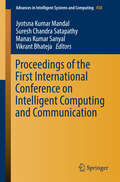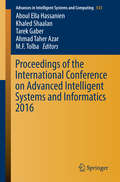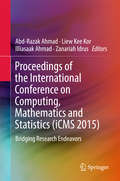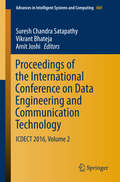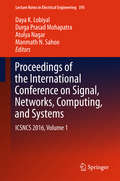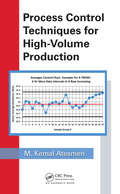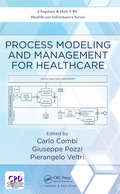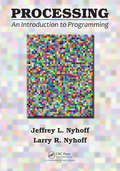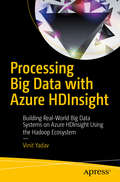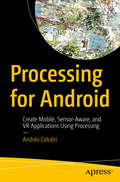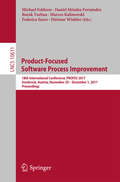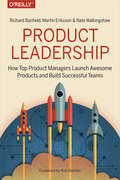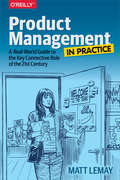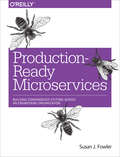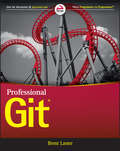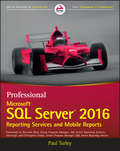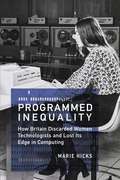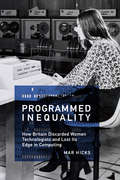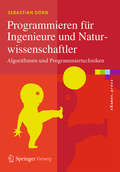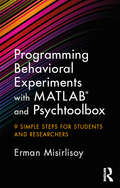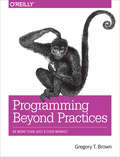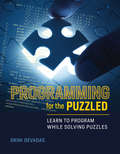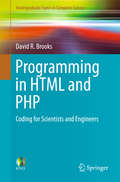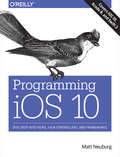- Table View
- List View
Proceedings of the First International Conference on Intelligent Computing and Communication
by Jyotsna Kumar Mandal Suresh Chandra Satapathy Manas Kumar Sanyal Vikrant BhatejaThe book covers a wide range of topics in Computer Science and Information Technology including swarm intelligence, artificial intelligence, evolutionary algorithms, and bio-inspired algorithms. It is a collection of papers presented at the First International Conference on Intelligent Computing and Communication (ICIC2) 2016. The prime areas of the conference are Intelligent Computing, Intelligent Communication, Bio-informatics, Geo-informatics, Algorithm, Graphics and Image Processing, Graph Labeling, Web Security, Privacy and e-Commerce, Computational Geometry, Service Orient Architecture, and Data Engineering.
Proceedings of the International Conference on Advanced Intelligent Systems and Informatics 2016
by Aboul Ella Hassanien Khaled Shaalan Tarek Gaber Ahmad Taher Azar M. F. TolbaThis book gathers the proceedings of the 2nd International Conference on Advanced Intelligent Systems and Informatics (AISI2016), which took place in Cairo, Egypt during October 24-26, 2016. This international interdisciplinary conference, which highlighted essential research and developments in the field of informatics and intelligent systems, was organized by the Scientific Research Group in Egypt (SRGE) and sponsored by the IEEE Computational Intelligence Society (Egypt chapter) and the IEEE Robotics and Automation Society (Egypt Chapter). The book's content is divided into four main sections: Intelligent Language Processing, Intelligent Systems, Intelligent Robotics Systems, and Informatics.
Proceedings of the International Conference on Computing, Mathematics and Statistics (iCMS #2015)
by Abd-Razak Ahmad Liew Kee Kor Illiasaak Ahmad Zanariah IdrusThis proceedings volume consists of refereed papers presented at the Second International Conference on Computing, Mathematics and Statistics (iCMS 2015) held in Langkawi, Malaysia in November 2015. Divided into three sections - Computer Science, Mathematics and Statistics - the book includes both quantitative and qualitative research that confronts current societal issues. Within the main sections, the book also covers education based research works and the applications of computer and mathematical sciences in social science, business, industries and the life and hard sciences. Drawing on the theme Bridging Research Endeavor on Computing, Mathematics and Statistics, each of the conference papers are carefully selected and edited to cater to readers from diverse applied and social sciences backgrounds. The book allows for the contemplation and reflection on the possibility of the knowledge growth and knowledge sharing in building a better world for future generations.
Proceedings of the International Conference on Data Engineering and Communication Technology
by Amit Joshi Vikrant Bhateja Suresh Chandra SatapathyThis two-volume book contains research work presented at the First International Conference on Data Engineering and Communication Technology (ICDECT) held during March 10-11, 2016 at Lavasa, Pune, Maharashtra, India. The book discusses recent research technologies and applications in the field of Computer Science, Electrical and Electronics Engineering. The aim of the Proceedings is to provide cutting-edge developments taking place in the field data engineering and communication technologies which will assist the researchers and practitioners from both academia as well as industry to advance their field of study.
Proceedings of the International Conference on Signal, Networks, Computing, and Systems
by Daya K. Lobiyal Durga Prasad Mohapatra Atulya Nagar Manmath N. SahooThe book is a collection of high-quality peer-reviewed research papers presented in the first International Conference on Signal, Networks, Computing, and Systems (ICSNCS 2016) held at Jawaharlal Nehru University, New Delhi, India during February 25-27, 2016. The book is organized in to two volumes and primarily focuses on theory and applications in the broad areas of communication technology, computer science and information security. The book aims to bring together the latest scientific research works of academic scientists, professors, research scholars and students in the areas of signal, networks, computing and systems detailing the practical challenges encountered and the solutions adopted.
Process Control Techniques for High-Volume Production
by M. Kemal AtesmenThis book details most common statistical process control tools with many examples for high-volume production. It aims to make elements of high-volume production process control simple and easy to understand. It lets you thoroughly understand process controls instead of blindly trusting software tools that operate as black boxes. If you are dealing with high-volume production as an operator, line supervisor, inspector, process engineer, quality engineer, manufacturing manager, plant manager, or president of the company, you have to understand the statistical process control basics explained in this book in order to be successful.
Process Modeling and Management for Healthcare (Chapman & Hall/CRC Healthcare Informatics Series)
by Carlo Combi Giuseppe Pozzi Pierangelo VeltriFrom the Foreword: "[This book] provides a comprehensive overview of the fundamental concepts in healthcare process management as well as some advanced topics in the cutting-edge research of the closely related areas. This book is ideal for graduate students and practitioners who want to build the foundations and develop novel contributions in healthcare process modeling and management." --Christopher Yang, Drexel University Process modeling and process management are traversal disciplines which have earned more and more relevance over the last two decades. Several research areas are involved within these disciplines, including database systems, database management, information systems, ERP, operations research, formal languages, and logic. Process Modeling and Management for Healthcare provides the reader with an in-depth analysis of what process modeling and process management techniques can do in healthcare, the major challenges faced, and those challenges remaining to be faced. The book features contributions from leading authors in the field. The book is structured into two parts. Part one covers fundamentals and basic concepts in healthcare. It explores the architecture of a process management environment, the flexibility of a process model, and the compliance of a process model. It also features a real application domain of patients suffering from age-related macular degeneration. Part two of the book includes advanced topics from the leading frontiers of scientific research on process management and healthcare. This section of the book covers software metrics to measure features of the process model as a software artifact. It includes process analysis to discover the formal properties of the process model prior to deploying it in real application domains. Abnormal situations and exceptions, as well as temporal clinical guidelines, are also presented in depth Pro.
Processing: An Introduction to Programming
by Jeffrey L. Nyhoff Larry R. NyhoffThis book demonstrates how Processing is an excellent language for beginners to learn the fundamentals of computer programming. Originally designed to make it simpler for digital artists to learn to program, Processing is a wonderful first language for anyone to learn. Given its origins, Processing enables a multimodal approach to programming instruction, well suited to students with interests in computer science or in the arts and humanities. The book uses Processing’s capabilities for graphics and interactivity in order to create examples that are simple, illustrative, interesting, and fun. It is designed to appeal to a broad range of readers, including those who want to learn to program to create digital art, as well as those who seek to learn to program to process numerical information or data. It can be used by students and instructors in a first course on programming, as well as by anyone eager to teach them self to program. Following a traditional sequence of topics for introducing programming, the book introduces key computer science concepts, without overwhelming readers with extensive detail. Additional exercises are available, as are other supplementary materials for instructors looking to introduce even more computer science concepts associated with the topics. Several online chapters are also provided that introduce slightly more advanced topics in Processing, such as two-dimensional arrays, manipulation of strings, and file input and output. The conversational style and pace of the book are based upon the authors’ extensive experience with teaching programming to a wide variety of beginners in a classroom. No prior programming experience is expected.
Processing Big Data with Azure HDInsight
by Vinit YadavGet a jump start on using Azure HDInsight and Hadoop Ecosystem components. As most Hadoop and Big Data projects are written in either Java, Scala, or Python, this book minimizes the effort to learn another language and is written from the perspective of a . NET developer. Hadoop components are covered, including Hive, Pig, HBase, Storm, and Spark on Azure HDInsight, and code samples are written in . NET only. Processing Big Data with Azure HDInsight covers the fundamentals of big data, how businesses are using it to their advantage, and how Azure HDInsight fits into the big data world. This book introduces Hadoop and big data concepts and then dives into creating different solutions with HDInsight and the Hadoop Ecosystem. It covers concepts with real-world scenarios and code examples, making sure you get hands-on experience. The best way to utilize this book is to practice while reading. After reading this book you will be familiar with Azure HDInsight and how it can be utilized to build big data solutions, including batch processing, stream analytics, interactive processing, and storing and retrieving data in an efficient manner. What You'll Learn Understand the fundamentals of HDInsight and Hadoop Work with HDInsight cluster Query with Apache Hive and Apache Pig Store and retrieve data with Apache HBase Stream data processing using Apache Storm Work with Apache Spark Who This Book Is For Software developers, technical architects, data scientists/analyts, and Hadoop administrators who want to develop on Microsoft's managed Hadoop offering, HDInsight
Processing for Android: Create Mobile, Sensor-Aware, and VR Applications Using Processing
by Andrés ColubriLearn how to use the Processing programming language and environment to create Android applications with ease. This book covers the basics of the Processing language, allowing users to effectively program interactive graphics in 2D and 3D. It also details the application of these techniques to different types of Android devices (smartphones, tablets, wearables and smartwatches). Processing for Android walks you through the steps of taking an initial idea to a final app. With this book, you will be able to write engaging apps with interactive visuals driven by motion and location information obtained from the device’s sensors; including health data from the wearer, like step count and heart rate. An advantage of Processing for Android over more complex programming environments is the ability for users to focus on the interactions and visual output of their code rather than in the implementation details of the Android platform. This book goes through a comprehensive series of hand-on projects, ranging from simple sketches to more complex projects involving sensors and integration with larger apps. It also covers important aspects such as exporting your Processing projects as signed apps are ready to upload to the Google Play store and be share with the world!What You'll LearnWrite apps and live wallpapers for smartphones and tabletsDesign and implement interactive watch facesCreate Virtual Reality experiences for Cardboard devicesIntegrate Processing sketches into larger apps and Android StudioExport projects as completed apps ready to distribute through Google Play StoreWho This Book Is ForArtists, designers, students, researchers, and hobbyists who are not necessarily Android experts, but are looking to write mobile apps that make creative use of interactive graphics, sensor data, and virtual reality.
Product-Focused Software Process Improvement: 18th International Conference, PROFES 2017, Innsbruck, Austria, November 29–December 1, 2017, Proceedings (Lecture Notes in Computer Science #10611)
by Dietmar Winkler Michael Felderer Federica Sarro Daniel Méndez Fernández Burak Turhan Marcos KalinowskiThis book constitutes the refereed proceedings of the 18th International Conference on Product-Focused Software Process Improvement, PROFES 2017, held in Innsbruck, Austria, in November/December 2017. The 17 revised full papers presented together with 10 short papers, 21 workshop papers. 3 posters and tool demonstrations papers, and 4 tutorials were carefully reviewed and selected from 72 submissions. The papers are organized in topical sections on : Agile software Development; Data science and analytics; Software engineering processes and frameworks; Industry relevant qualitative research; User and value centric approaches; Software startups; Serum; Software testing.
Product Leadership: How Top Product Managers Launch Awesome Products and Build Successful Teams
by Martin Eriksson Nate Walkingshaw Richard BanfieldIn today’s lightning-fast technology world, good product management is critical to maintaining a competitive advantage. Yet, managing human beings and navigating complex product roadmaps is no easy task, and it’s rare to find a product leader who can steward a digital product from concept to launch without a couple of major hiccups. Why do some product leaders succeed while others don’t?This insightful book presents interviews with nearly 100 leading product managers from all over the world. Authors Richard Banfield, Martin Eriksson, and Nate Walkingshaw draw on decades of experience in product design and development to capture the approaches, styles, insights, and techniques of successful product managers. If you want to understand what drives good product leaders, this book is an irreplaceable resource.In three parts, Product Leadership helps you explore:Themes and patterns of successful teams and their leaders, and ways to attain those characteristicsBest approaches for guiding your product team through the startup, emerging, and enterprise stages of a company’s evolutionStrategies and tactics for working with customers, agencies, partners, and external stakeholders
Product Management in Practice: A Real-World Guide to the Key Connective Role of the 21st Century
by Matt LeMayProduct management has become a critical connective role for modern organizations, from small technology startups to global corporate enterprises. And yet the day-to-day work of product management remains largely misunderstood. In theory, product management is about building products that people love. The real-world practice of product management is often about difficult conversations, practical compromises, and hard-won incremental gains.In this book, author Matt LeMay focuses on the CORE connective skills—communication, organization, research, execution—that can build a successful product management practice across industries, organizations, teams, and toolsets.For current and would-be product managers, this book explores:Real-world tactics for facilitating collaboration and communicationHow to talk to users and work with executivesThe importance of setting clear and actionable goalsUsing roadmaps to connect and align your teamA values-first approach to implementing Agile practicesStories that convey realities of product management in the fieldCommon behavioral traps that turn good product managers bad
Product Roadmaps Relaunched: How to Set Direction while Embracing Uncertainty
by C. Todd Lombardo Bruce Mccarthy Evan Ryan Michael ConnorsA good product roadmap is one of the most important and influential documents an organization can develop, publish, and continuously update. In fact, this one document can steer an entire organization when it comes to delivering on company strategy.This practical guide teaches you how to create an effective product roadmap, and demonstrates how to use the roadmap to align stakeholders and prioritize ideas and requests. With it, you’ll learn to communicate how your products will make your customers and organization successful.Whether you're a product manager, product owner, business analyst, program manager, project manager, scrum master, lead developer, designer, development manager, entrepreneur, or business owner, this book will show you how to:Articulate an inspiring vision and goals for your productPrioritize ruthlessly and scientificallyProtect against pursuing seemingly good ideas without evaluation and prioritizationEnsure alignment with stakeholdersInspire loyalty and over-delivery from your teamGet your sales team working with you instead of against youBring a user and buyer-centric approach to planning and decision-makingAnticipate opportunities and stay ahead of the gamePublish a comprehensive roadmap without overcommitting
Production-Ready Microservices: Building Standardized Systems Across an Engineering Organization
by Susan J. FowlerOne of the biggest challenges for organizations that have adopted microservice architecture is the lack of architectural, operational, and organizational standardization. After splitting a monolithic application or building a microservice ecosystem from scratch, many engineers are left wondering what's next. In this practical book, author Susan Fowler presents a set of microservice standards in depth, drawing from her experience standardizing over a thousand microservices at Uber. You'll learn how to design microservices that are stable, reliable, scalable, fault tolerant, performant, monitored, documented, and prepared for any catastrophe.Explore production-readiness standards, including:Stability and Reliability: develop, deploy, introduce, and deprecate microservices; protect against dependency failuresScalability and Performance: learn essential components for achieving greater microservice efficiencyFault Tolerance and Catastrophe Preparedness: ensure availability by actively pushing microservices to fail in real timeMonitoring: learn how to monitor, log, and display key metrics; establish alerting and on-call proceduresDocumentation and Understanding: mitigate tradeoffs that come with microservice adoption, including organizational sprawl and technical debt
Professional Git
by Brent LasterLeverage the power of Git to smooth out the development cycle Professional Git takes a professional approach to learning this massively popular software development tool, and provides an up-to-date guide for new users. More than just a development manual, this book helps you get into the Git mindset—extensive discussion of corollaries to traditional systems as well as considerations unique to Git help you draw upon existing skills while looking out—and planning for—the differences. Connected labs and exercises are interspersed at key points to reinforce important concepts and deepen your understanding, and a focus on the practical goes beyond technical tutorials to help you integrate the Git model into your real-world workflow. Git greatly simplifies the software development cycle, enabling users to create, use, and switch between versions as easily as you switch between files. This book shows you how to harness that power and flexibility to streamline your development cycle. Understand the basic Git model and overall workflow Learn the Git versions of common source management concepts and commands Track changes, work with branches, and take advantage of Git's full functionality Avoid trip-ups and missteps common to new users Git works with the most popular software development tools and is used by almost all of the major technology companies. More than 40 percent of software developers use it as their primary source control tool, and that number continues to grow; the ability to work effectively with Git is rapidly approaching must-have status, and Professional Git is the comprehensive guide you need to get up to speed quickly.
Professional Microsoft SQL Server 2016 Reporting Services and Mobile Reports
by Christopher Finlan Paul Turley Riccardo MutiOptimize reporting and BI with Microsoft SQL Server 2016 Professional Microsoft SQL Server 2016 Reporting Services and Mobile Reports provides a comprehensive lesson in business intelligence (BI), operational reporting and Reporting Services architecture using a clear, concise tutorial approach. You'll learn effective report solution design based upon many years of experience with successful report solutions. Improve your own reports with advanced, best-practice design, usability, query design, and filtering techniques. Expert guidance provides insight into common report types and explains where each could be made more efficient, while providing step-by step instruction on Microsoft SQL Server 2016. All changes to the 2016 release are covered in detail, including improvements to the Visual Studio Report Designer (SQL Server Data Tools) and Report Builder, Mobile Dashboard Designer, the new Report Portal Interface, HTML-5 Rendering, Power BI integration, Custom Parameters Pane, and more. The Microsoft SQL Server 2016 release will include significant changes. New functionality, new capabilities, re-tooled processes, and changing support require a considerable update to existing knowledge. Whether you're starting from scratch or simply upgrading, this book is an essential guide to report design and business intelligence solutions. Understand BI fundamentals and Reporting Services architecture Learn the ingredients to a successful report design Get up to speed on Microsoft SQL Server 2016 Grasp the purpose behind common designs to optimize your reporting Microsoft SQL Server Reporting Services makes reporting faster, easier, and more powerful than ever in web, desktop and portal solutions. Compatibility with an extensive variety of data sources makes it a go-to solution for organizations across the globe. The 2016 release brings some of the biggest changes in years, and the full depth and breadth of these changes can create a serious snag in your workflow. For a clear tutorial geared toward the working professional, Professional Microsoft SQL Server 2016 Reporting Services and Mobile Reports is the ideal guide for getting up to speed and producing successful reports.
Programmed Inequality: How Britain Discarded Women Technologists and Lost Its Edge in Computing
by Marie HicksIn 1944, Britain led the world in electronic computing. By 1974, the British computer industry was all but extinct. What happened in the intervening thirty years holds lessons for all postindustrial superpowers. As Britain struggled to use technology to retain its global power, the nation's inability to manage its technical labor force hobbled its transition into the information age. In Programmed Inequality, Marie Hicks explores the story of labor feminization and gendered technocracy that undercut British efforts to computerize. That failure sprang from the government's systematic neglect of its largest trained technical workforce simply because they were women. Women were a hidden engine of growth in high technology from World War II to the 1960s. As computing experienced a gender flip, becoming male-identified in the 1960s and 1970s, labor problems grew into structural ones and gender discrimination caused the nation's largest computer user -- the civil service and sprawling public sector -- to make decisions that were disastrous for the British computer industry and the nation as a whole.Drawing on recently opened government files, personal interviews, and the archives of major British computer companies, Programmed Inequality takes aim at the fiction of technological meritocracy. Hicks explains why, even today, possessing technical skill is not enough to ensure that women will rise to the top in science and technology fields. Programmed Inequality shows how the disappearance of women from the field had grave macroeconomic consequences for Britain, and why the United States risks repeating those errors in the twenty-first century.
Programmed Inequality: How Britain Discarded Women Technologists and Lost Its Edge in Computing (History of Computing)
by Mar HicksHow Britain lost its early dominance in computing by systematically discriminating against its most qualified workers: women.In 1944, Britain led the world in electronic computing. By 1974, the British computer industry was all but extinct. What happened in the intervening thirty years holds lessons for all postindustrial superpowers. As Britain struggled to use technology to retain its global power, the nation's inability to manage its technical labor force hobbled its transition into the information age. In Programmed Inequality, Mar Hicks explores the story of labor feminization and gendered technocracy that undercut British efforts to computerize. That failure sprang from the government's systematic neglect of its largest trained technical workforce simply because they were women. Women were a hidden engine of growth in high technology from World War II to the 1960s. As computing experienced a gender flip, becoming male-identified in the 1960s and 1970s, labor problems grew into structural ones and gender discrimination caused the nation's largest computer user—the civil service and sprawling public sector—to make decisions that were disastrous for the British computer industry and the nation as a whole.Drawing on recently opened government files, personal interviews, and the archives of major British computer companies, Programmed Inequality takes aim at the fiction of technological meritocracy. Hicks explains why, even today, possessing technical skill is not enough to ensure that women will rise to the top in science and technology fields. Programmed Inequality shows how the disappearance of women from the field had grave macroeconomic consequences for Britain, and why the United States risks repeating those errors in the twenty-first century.
Programmieren für Ingenieure und Naturwissenschaftler
by Sebastian DörnZiel des Buches ist es, Studierenden der Ingenieur- oder Naturwissenschaften die Programmierung als Schlüsselqualifikation mit zahlreichen Anwendungsmöglichkeiten vorzustellen. Großer Wert wird auf eine praxisorientierte und verständliche Darstellung gelegt. Der Autor behandelt die Anwendungsbereiche des Operations Research, der Medizinischen Informatik und der Automatisierungstechnik. Neben der Darstellung objektorientierter Entwurfsmuster werden zentrale Programmierkonzepte und fortgeschrittene Datenstrukturen vorgestellt. Suchalgorithmen, Graphen, Automaten und reguläre Sprachen werden dem Leser praxisnah vermittelt. Die Grundlagen zur Bildverarbeitung im Bereich der Bildfilterung, Registrierung und Segmentierung runden das Buch ab.
Programming Behavioral Experiments with MATLAB and Psychtoolbox: 9 Simple Steps for Students and Researchers
by Erman MisirlisoyHuman behavior is fascinating so it’s no surprise that psychologists and neuroscientists spend their lives designing rigorous experiments to understand it. MATLAB is one of the most widely used pieces of software for designing and running behavioral experiments, and it opens up a world of quick and flexible experiment programming. This book offers a step-by-step guide to using MATLAB with Psychtoolbox to create customisable experiments. Its pocket size and simple language allow you to get straight to the point and help you to learn fast in order to complete your work in great time. In nine simple steps, it guides you all the way from setting parameters for your experiment to analysing the output. Gone are the daunting days of working through hundreds of irrelevant and complicated documents, as in this handy book, Erman Misirlisoy coaxes you in the right direction with his friendly and encouraging tricks and tips. If you want to learn how to develop your own experiments to collect and analyse behavioral data, then this book is a must-read. Whether you are a student in experimental psychology, a researcher in cognitive neuroscience, or simply someone who wants to run behavioral tasks on your friends for fun, this book will offer you the skills to succeed.
Programming Beyond Practices: Be More Than Just a Code Monkey
by Gregory T BrownWriting code is the easy part of your work as a software developer. This practical book lets you explore the other 90%--everything from requirements discovery and rapid prototyping to business analysis and designing for maintainability. Instead of providing neatly packaged advice from on high, author Gregory Brown presents detailed examples of the many problems developers encounter, including the thought process it takes to solve them.He does this in an unusual and entertaining fashion by making you the main character in a series of chapter-length stories. As these stories progress, the examples become more complex, and your responsibilities increase. Together, these stories take you on a journey that will make you question and refine the way you think about, and work on, software projects.Steps in this unique journey include:Using prototypes to explore project ideasSpotting hidden dependencies in incremental changesIdentifying the pain points of service integrationsDeveloping a rigorous approach towards problem-solvingDesigning software from the bottom upData modeling in an imperfect worldGradual process improvement as an antidote for over-commitmentThe future of software development
Programming for the Puzzled: Learn to Program While Solving Puzzles (The\mit Press Ser.)
by Srini DevadasLearning programming with one of “the coolest applications around”: algorithmic puzzles ranging from scheduling selfie time to verifying the six degrees of separation hypothesis.This book builds a bridge between the recreational world of algorithmic puzzles (puzzles that can be solved by algorithms) and the pragmatic world of computer programming, teaching readers to program while solving puzzles. Few introductory students want to program for programming's sake. Puzzles are real-world applications that are attention grabbing, intriguing, and easy to describe. Each lesson starts with the description of a puzzle. After a failed attempt or two at solving the puzzle, the reader arrives at an Aha! moment—a search strategy, data structure, or mathematical fact—and the solution presents itself. The solution to the puzzle becomes the specification of the code to be written. Readers will thus know what the code is supposed to do before seeing the code itself. This represents a pedagogical philosophy that decouples understanding the functionality of the code from understanding programming language syntax and semantics. Python syntax and semantics required to understand the code are explained as needed for each puzzle.Readers need only the rudimentary grasp of programming concepts that can be obtained from introductory or AP computer science classes in high school. The book includes more than twenty puzzles and more than seventy programming exercises that vary in difficulty. Many of the puzzles are well known and have appeared in publications and on websites in many variations. They range from scheduling selfie time with celebrities to solving Sudoku problems in seconds to verifying the six degrees of separation hypothesis. The code for selected puzzle solutions is downloadable from the book's website; the code for all puzzle solutions is available to instructors.
Programming in HTML and PHP
by David R. BrooksThis concise and accessible textbook will enable readers to quickly develop the working skills necessary to solve computational problems in a server-based environment, using HTML and PHP. The importance of learning by example (as opposed to simply learning by copying) is emphasized through extensive use of hands-on exercises and examples, with a specific focus on useful science and engineering applications. The clearly-written text is designed to be simple to follow for the novice student, without requiring any background in programming or mathematics beyond algebra. Topics and features: describes the creation of HTML pages and the characteristics of HTML documents, showing how to use HTML tables, forms, lists, and frames to organize documents for use with PHP applications; explains how to set up a PHP environment, using a local or remote server; introduces the capabilities and syntax of the PHP language, including coverage of array syntax and use; examines user-defined functions in programming, summarizing PHP functions for reading and writing files, viewing the content of variables, and manipulating strings; reviews the PHP GD graphics library, presenting applications for creating pie charts, bar graphs, and line graphs suitable for displaying scientific data; includes appendices listing HTML and ASCII special characters, and highlighting the essential basic strategies for solving computational problems. Supplying all of the tools necessary to begin coding in HTML and PHP, this invaluable textbook is ideal for undergraduate students taking introductory courses in programming. The book will also serve as a helpful self-study text for professionals in any technical field.
Programming iOS 10: Dive Deep into Views, View Controllers, and Frameworks
by Matt NeuburgIf you're grounded in the basics of Swift, Xcode, and the Cocoa framework, this book provides a structured explanation of all essential real-world iOS app components. Through deep exploration and copious code examples, you'll learn how to create views, manipulate view controllers, and add features from iOS frameworks.Stay up-to-date on iOS 10 innovations, such as property animators, force touch, speech recognition, and the User Notification framework, as well as Xcode 8 improvements for autolayout and asset catalogs. All example code (now rewritten in Swift 3) is available on GitHub for you to download, study, and run.Create, arrange, draw, layer, and animate views that respond to touchUse view controllers to manage multiple screens of interfaceMaster interface classes for scroll views, table views, text, popovers, split views, web views, and controlsDive into frameworks for sound, video, maps, and sensorsAccess user libraries: music, photos, contacts, and calendarExplore additional topics, including files, networking, and threadsWant to brush up on the basics? Pick up iOS 10 Programming Fundamentals with Swift (978-1-491-97007-2) to learn about Swift, Xcode, and Cocoa. Together with Programming iOS 10, you'll gain a solid, rigorous, and practical understanding of iOS 10 development.
